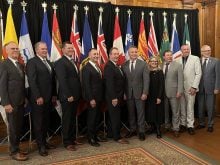The first blows leading up to Manitoba’s fall election landed as the Association of Manitoba Municipalities (AMM) hosted an April 4 forum featuring major party leaders.
Candidates for Manitoba’s three main political parties sparred over which one best represents the interests of AMM members.
Why it matters: Campaigns have not officially launched for the provincial election, slated for Oct. 3, but a recent forum laid the groundwork.
Read Also

Seeding Indigenous agricultural prosperity
National Circle for Indigenous Agriculture and Food says Indigenous agricultural success needs strong relationships.
While Liberal leader Dougald Lamont didn’t hold back from criticizing the NDP, the majority of the barbs from both Lamont and NDP leader Wab Kinew were aimed at Premier Heather Stefanson.
“The premier was part of the previous government as well,” Lamont said. “So the question is, why would you trust somebody who broke the system to fix it?”
Kinew said it would “take years to fix the damage that the PCs have caused to health care.”
The comment was in response to a statement from Stefanson, who said improvements to health care would not be a quick fix.
Health care dominated much of the debate.
Stefanson said her party has earmarked $200 million to hire 2,000 new health care workers. Many of those, she said, would be employed in rural communities.
The NDP also promised new health care hires. Kinew said his party’s plans include incentives to draw workers away from other provinces. He didn’t give details on how this would be achieved, saying the NDP plan would be released in May.
“We are going to have to have a competitive offer, especially when the big provinces like Ontario and B.C. are offering financial incentives,” he said.
Stefanson questioned the lack of detail.
“How does he plan to pay for all of this? He hasn’t come up with an answer to that,” she said. “We’ve seen from past NDP history how they do that; they raise your taxes. That is the hidden agenda of what the NDP plans to do. Don’t be fooled again by them.”
The debate was largely framed by health care issues once discussion turned to centralization of services. The NDP and Liberal leaders criticized the Tories for allowing rural health services to migrate to Winnipeg.
“It seems counterintuitive,” Lamont said. “But it’s the PCs who brought in RHAs [Rural Health Authorities]. It’s the PCs who brought in Shared Health, creating two entirely new levels of bureaucracy for our health care system.”
Stefanson pointed to recent upgrades for cancer care at the Brandon Regional Health Centre. She used the improvements as an example of her party moving in the right direction in terms of decentralization.
“We need investments in these communities to make sure that people don’t have to fly or drive into Winnipeg and that they can get that cancer care at the Brandon hospital and make it a day trip,” she said.
When the leaders began debating infrastructure, perennial issues like the Lake St. Martin and Lake Manitoba diversion project were raised.
“There’s a massive infrastructure project in the Interlake right now that’s needed for flood mitigation,” Kinew said. “How much progress has been made on that over the past seven years? Almost nothing.”
Delays around the project, then under the last NDP government, were an election issue in 2016. The project hit a further roadblock in 2019 under the PCs when it did not pass federal environmental assessment standards.
Road conditions, rural broadband and cellular service were also raised. Kinew brought up conditions on Highway 75, and Lamont talked about the importance of rural cellular service. “That’s another thing that needs to be a huge priority,” he said. “Cell service is not a luxury. It’s absolutely essential.”
“We’re listening, and we’re getting things done,” Stefanson said. “Yes, there’s more work that needs to be done. But we’re committed to making sure we get that work done together with you.”
The NDP and Liberal leaders argued that structural changes are needed in how the province doles out infrastructure money to municipalities. Lamont said an “infrastructure secretariat” that includes municipalities is needed to negotiate the terms of spending and make sure funding is available and predictable.
Kinew said the NDP would set up a “blue ribbon panel” where local experts, municipal leaders and representatives from different sectors of the economy would tell the government where spending was needed.
The leaders closed with a debate over policing. The conversation ranged from rural crime to municipal enforcement and the role of the RCMP. The biggest news came as Kinew promised to re-establish a correctional facility in Dauphin. The Dauphin Correctional Centre was shut down in 2020.
AMM president Kam Blight said he was pleased with the forum.
“We had municipal priorities being talked about by all three provincial leaders. There was a lot of passion brought forward by the provincial leaders and it was just a great discussion,” he said.
















